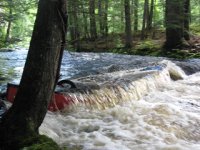- Joined
- Jan 15, 2016
- Messages
- 177
- Reaction score
- 0
Simply put, this is when the boat is turned off-course to arrive broadside to wind and waves.
The turning of the boat, however-- the yawing, slewing, or sudden rotation about the vertical axis is where the meat of the story lies. Where do these turning forces come from, and what can we do to minimize their effects?
There is a litany of sub-topics that fall under the heading of 'Broaching', and it's a weighty conversation; sub-topics might include the following: hydrodynamics of wave action and the 'relative' flow between crests, wind strength, wind direction, wave height, wave period, boat size, effective 'sail' distribution (all that sticks up above the water), weight distribution, hull design, how a full-displacement hull (a canoe) turns, effective paddle strokes, and the use of drogues.
There are many more, and I invite conversation on this fascinating aspect of our favourite pastime.
While the dynamics of turning may be the body of the story, the ending isn't always of the Hollywood type-- many of us have seen the turn-broach-capsize triplet that has ended in real-life tragedy.
The turning of the boat, however-- the yawing, slewing, or sudden rotation about the vertical axis is where the meat of the story lies. Where do these turning forces come from, and what can we do to minimize their effects?
There is a litany of sub-topics that fall under the heading of 'Broaching', and it's a weighty conversation; sub-topics might include the following: hydrodynamics of wave action and the 'relative' flow between crests, wind strength, wind direction, wave height, wave period, boat size, effective 'sail' distribution (all that sticks up above the water), weight distribution, hull design, how a full-displacement hull (a canoe) turns, effective paddle strokes, and the use of drogues.
There are many more, and I invite conversation on this fascinating aspect of our favourite pastime.
While the dynamics of turning may be the body of the story, the ending isn't always of the Hollywood type-- many of us have seen the turn-broach-capsize triplet that has ended in real-life tragedy.

